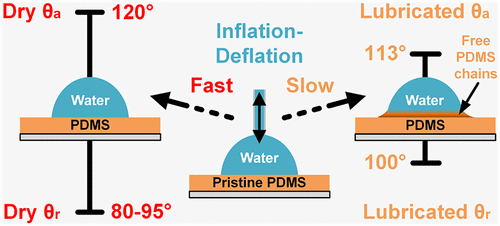Our official English website, www.x-mol.net, welcomes your
feedback! (Note: you will need to create a separate account there.)
Adaptive Wetting of Polydimethylsiloxane.
Langmuir ( IF 3.7 ) Pub Date : 2020-06-04 , DOI: 10.1021/acs.langmuir.0c00538 William S Y Wong 1 , Lukas Hauer 1 , Abhinav Naga 1 , Anke Kaltbeitzel 1 , Philipp Baumli 1 , Rüdiger Berger 1 , Maria D'Acunzi 1 , Doris Vollmer 1 , Hans-Jürgen Butt 1
Langmuir ( IF 3.7 ) Pub Date : 2020-06-04 , DOI: 10.1021/acs.langmuir.0c00538 William S Y Wong 1 , Lukas Hauer 1 , Abhinav Naga 1 , Anke Kaltbeitzel 1 , Philipp Baumli 1 , Rüdiger Berger 1 , Maria D'Acunzi 1 , Doris Vollmer 1 , Hans-Jürgen Butt 1
Affiliation

|
To better understand the wetting of cross-linked polydimethylsiloxane (PDMS), we measured advancing and receding contact angles of sessile water drops on cross-linked PDMS as a function of contact line velocity (up to 100 μm/s). Three types of samples were investigated: pristine PDMS, PDMS where oligomers were removed by toluene treatment, and PDMS with an enriched concentration of oligomers. Depending on the velocity of advancing contact lines and the contact time with water, different modes of wetting were observed: one with a relatively low contact angle hysteresis (Δθ ≈ 10°) and one with a larger hysteresis. We attribute the low hysteresis state, called the lubricated state, to the enrichment of free oligomers at the water–PDMS interface. The enrichment of oligomers is induced by drop contact. The kinetics of the transition to the lubricated state can be described by adaptation theory. PDMS adapts to the presence of water by an enrichment of free oligomers at the interface and a correlated reduction in interfacial tension.
中文翻译:

聚二甲基硅氧烷的自适应润湿。
为了更好地了解交联聚二甲基硅氧烷(PDMS)的润湿性,我们测量了交联PDMS上无水水滴的前进和后退接触角随接触线速度(最大100μm/ s)的变化。研究了三种类型的样品:原始PDMS,通过甲苯处理去除了低聚物的PDMS,以及富集了低聚物浓度的PDMS。根据前进的接触线的速度和与水的接触时间,观察到了不同的润湿方式:一种具有相对较低的接触角滞后(Δθ≈10°),另一种具有较大的滞后。我们将低磁滞状态(称为润滑状态)归因于水-PDMS界面处游离低聚物的富集。寡聚体的富集通过液滴接触诱导。过渡到润滑状态的动力学可以通过适应理论来描述。PDMS通过在界面处富集游离低聚物并相应降低界面张力来适应水的存在。
更新日期:2020-07-07
中文翻译:

聚二甲基硅氧烷的自适应润湿。
为了更好地了解交联聚二甲基硅氧烷(PDMS)的润湿性,我们测量了交联PDMS上无水水滴的前进和后退接触角随接触线速度(最大100μm/ s)的变化。研究了三种类型的样品:原始PDMS,通过甲苯处理去除了低聚物的PDMS,以及富集了低聚物浓度的PDMS。根据前进的接触线的速度和与水的接触时间,观察到了不同的润湿方式:一种具有相对较低的接触角滞后(Δθ≈10°),另一种具有较大的滞后。我们将低磁滞状态(称为润滑状态)归因于水-PDMS界面处游离低聚物的富集。寡聚体的富集通过液滴接触诱导。过渡到润滑状态的动力学可以通过适应理论来描述。PDMS通过在界面处富集游离低聚物并相应降低界面张力来适应水的存在。











































 京公网安备 11010802027423号
京公网安备 11010802027423号